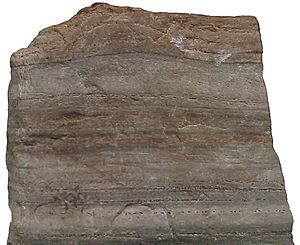Metamorphic rock facts for kids
A metamorphic rock is a type of rock that has been changed a lot by extreme heat and pressure. The word "metamorphic" comes from two Greek words: 'meta' meaning 'change' and 'morph' meaning 'form'. So, it literally means "changed form."


These rocks start as other types of rocks, like sedimentary rock, igneous rock, or even older metamorphic rocks. When they are buried deep underground, they get really hot (over 150 to 200 degrees Celsius) and are squeezed by huge amounts of pressure (like 1500 times the air pressure at sea level!). This causes big physical and chemical changes in the rock.
Deep under the Earth's surface, especially in the roots of mountain chains or near volcanoes, these forces are strong enough to change the shape of rock layers and the minerals inside them. Sedimentary rocks that have been through this often look like a giant twisted and heated them!
When rocks are heated and squeezed, the fossils they might have contained are usually destroyed. This is because the minerals in the rock recrystallize, meaning they form new crystals, which wipes out the fossil shapes.
Contents
How Rocks Transform
Rocks can change in different ways, depending on where they are and what forces act on them.
Regional Metamorphism
Regional metamorphism happens over very large areas of rock. Imagine huge sections of the Earth's crust being pushed together. This often happens when continents collide.
When rocks are buried deep down, they experience high temperatures and the enormous weight of all the rock layers above them. This intense heat and pressure cause them to change. Much of the lower part of the Earth's continents is made of metamorphic rock.
When continents crash into each other, they create huge mountain ranges. Along these "collision belts," rocks are squeezed, heated, and bent. If these changed rocks are later pushed up to the surface and exposed by erosion, you can see them as long belts or large areas of metamorphic rock.
Contact Metamorphism

Contact metamorphism happens when hot magma (molten rock from inside the Earth) pushes its way into existing solid rock. Think of it like a hot iron touching fabric.
The biggest changes happen right where the magma touches the surrounding rock. The temperatures are highest there. As you move further away from the magma, the temperature drops, and the changes to the rock become less noticeable.
Cool Examples of Metamorphic Rocks
Here are some well-known examples of metamorphic rocks:
- Marble is a beautiful metamorphic rock that forms from limestone. It's often used in buildings and sculptures.
- Slate is a metamorphic rock that forms from mudstone or shale. It's known for being flat and is often used for roofing tiles or blackboards.
- Quartzite is a very hard metamorphic rock that forms from sandstone.
Related pages
Images for kids
-
Metamorphic rock, deformed during the Variscan orogeny, at Vall de Cardós, Lérida, Spain
See also
 In Spanish: Roca metamórfica para niños
In Spanish: Roca metamórfica para niños







